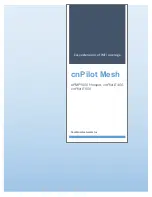
Copyright 2016. Cambium Networks Inc. All rights reserved.
4
In the CLI the configuration commands are same as the ones used for WLAN. The
additional CLI command is to enable mesh inside the WLAN context.
(cnWest-E400)# wireless wlan 1
(cnWest-E400)# mesh client
Mesh WLAN
One Wireless LAN has to be dedicated to Mesh, and the SSID on that wireless LAN
will be used by the radios to identify each other and form the connection. The same
SSID should be configured on the radios used for mesh base as well as the one used
on mesh client. This SSID will only allow connections from mesh peers, regular
wireless clients will not be allowed to associate on such an SSID.
Additional WLANs can be configured on the radio if the radio would be required to
service other clients in addition to forming the mesh link.
Mesh Security
The Mesh link can be secured with WPA2-Preshared security, which provides AES
encryption. To configure security select ‘WPA2-Preshared-keys’ under ‘Security’, then
configure a passphrase between 8 to 63 characters long. The same configuration
should be done on both ends of the link (client and base).
VLANs
The mesh link will bridge all packets across all VLANs on that access point. The Vlan
in the WLAN configuration page is the default vlan and should typically be configured
to the VLAN where the device has its primary IP address for management.
Radios
The Wireless LAN configured for mesh would by default be mapped to the 5GHz radio
on dual radio devices, and this is the recommended configuration. However it is
possible to enable mesh on the 2.4GHz radio, or even both 2.4GHz and 5GHz radios
of an access point.
Given the 5GHz radio supports wider channels (80MHz), and much higher modulation
schemes (802.11ac data rates) the recommendation would be to use the 5GHz radio
for backhaul and to service clients using the 2.4GHz radio on the AP.























